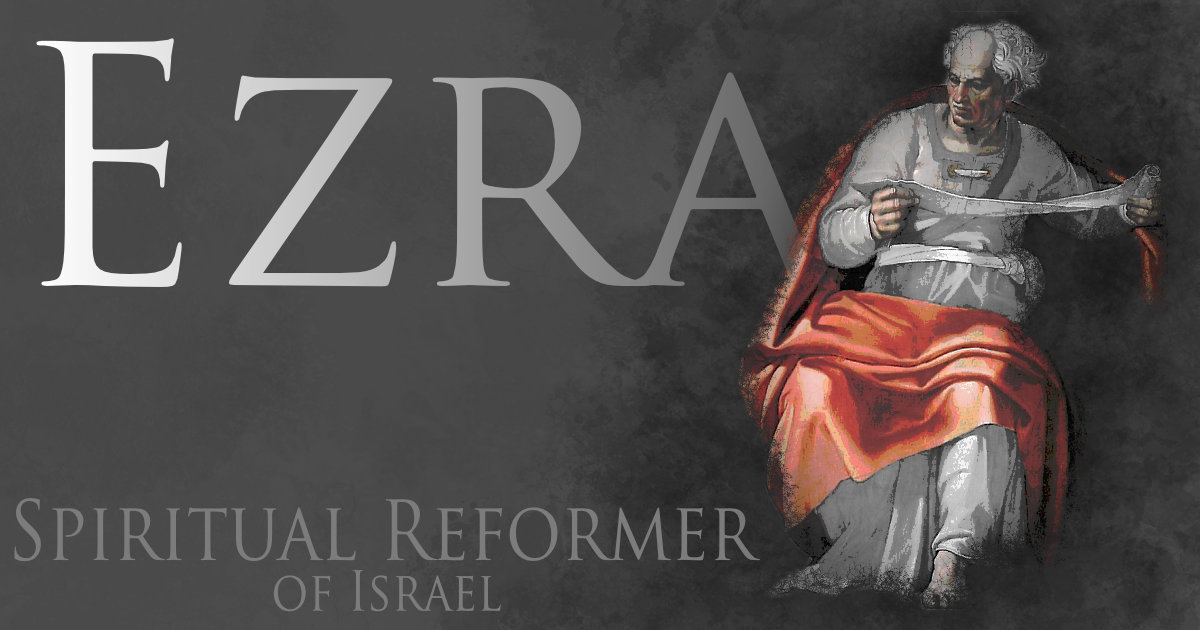עֶזרָא
Ezra
"help, assistance" from the verb עָזַר meaning, "to help, succour." (assistance and support in times of hardship and distress).
In the Hebrew Bible, Ezra-Nehemiah is considered to be one book.

Introduction
The Book of Ezra is a book of the Hebrew Bible; which formerly included the Book of Nehemiah in a single book, commonly distinguished in scholarship as Ezra–Nehemiah. The two became separated with the first printed rabbinic bibles of the early 16th century, following late medieval Latin Christian tradition.
Contents
Its subject is the Return to Zion following the close of the Babylonian captivity, and it is divided into two parts,
the first telling the story of the first return of exiles in the first year of Cyrus the Great (538 BC) and the completion and dedication of the new Temple in Jerusalem in the sixth year of Darius I (515 BC),
the second telling of the subsequent mission of Ezra to Jerusalem and his struggle to purify the Jews from marriage with non-Jews.
Together with the Book of Nehemiah, it represents the final chapter in the historical narrative of the Hebrew Bible.
Date
Koresh of Ezra 1:1 is called "king of Persia", which title was introduced not by Cyrus the Great but by his grandson and probable namesake Xerxes (486–465 BC).Scholars are divided over the chronological sequence of the activities of Ezra and Nehemiah. Ezra 7:8 says that Ezra arrived in Jerusalem in the seventh year of king Artaxerxes, while Nehemiah 2:1–9 has Nehemiah arriving in Artaxerxes' twentieth year. If this was Artaxerxes I (465–424 BC), then Ezra arrived in 458 and Nehemiah in 445 BC. Nehemiah 8–9, in which the two (possibly by editorial error) appear together, supports this scenario.
The rest of this comprehensive Wikipedia article on the book can be read here.
An extract from BHFA Volume 5
Ezra 6:15a
וְשֵׁיצִיא בַּיְתָה דְנָה
this the house and it was finished
KJB And this house was finished
NASB This temple was completed
ESV and this house was finished
NLT The Temple was completed
NIV The temple was completed
The first word is an Aramaic (Chaldean) word. Chaldean is an old name for the Aramaic language, particularly Biblical Aramaic.
Chaldean has a binyan called shapel in which the consonant shin and a vowel is prefixed onto the verb. This Chaldean verb is close to the Hebrew verb יָצָא meaning, "to go / come out" and here means, "bring out (to an end), = finish."
An extract from BHFA Volume 5
Ezra 7:6a
הוּא עֶזְרָא עָלָה מִבָּבֶל
from Babylon he went up Ezra this
KJB This Ezra went up from Babylon;
NASB This Ezra went up from Babylon,
ESV this Ezra went up from Babylonia.
NIV this Ezra came up from Babylon.
עֶזרָא
"help, assistance" from the verb עָזַר meaning, "to help, succor." (assistance and support in times of hardship and distress).
Ezra is the leading figure in the "Great Synagogue." According to Jewish tradition the "Great Assembly," or the "Great Synagogue," or "Synod," was an assembly of 120 scribes, sages, and prophets, in the period from the end of the biblical prophets (c. 430 BCE), to the early Hellenistic period (c. 320 BCE). It comprised such prophets as Haggai, Zechariah, Malachi (who is Ezra), Daniel, Hananiah, Mishael, Nehemiah ben Hachaliah, among others. Sometimes the "Great Assembly" is simply designated as "Ezra and his court of law."
Among the developments in Judaism that are attributed to the Great Assembly are:
The fixing of the Jewish biblical canon. The canon included the books of Ezekiel, Daniel, Esther, and the Twelve Minor Prophets.
They introduced the Feast of Purim.
They instituted the prayer known as the "Shemoneh 'esreh" as well as other synagogue prayers, rituals, and benedictions.